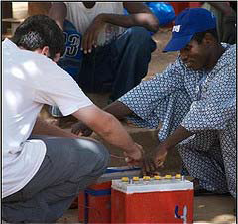Module 00- Micro-economy Kit
Micro-economy Kit Overview
Student Design Team Goal in ME 2700: Create a micro-economy kit (design project)
As an engineer, you directly touch people’s lives by being instrumental in designing products! In ME 2700, students work in teams and engaged in creating a micro-economy kit (project) that encourages/promotes self-sustainability and economic growth for underdeveloped/developing nations. In order to accomplish this task, your design team must:
- Perform research in order to identify a region/country and target population who are experiencing a basic need shortcoming/issue/concern.
- Design an engineering solution (a product or process) that would help the target population, and:
- Will allow them to redirect time and resources to a different activity that positively impacts quality of life
- Meets a basic need in a developing/underdeveloped nation
- Will improve or create a self-sustaining economic activity
- Will be made from a low cost kit, maximizing “local content/materials”
- Can be sold and serviced by local artisans
- Promotes and integrates sustainability
Start simple.
Use resources immediately available to you. Befriend Google, the ISU Library, and search the following:

Review summaries at World Bank, United Nations, World Health Organization, etc.
- TED videos can be inspiring
- Competitions (e.g., Dell Social Innovation Challenge) or Foundations (e.g., the Gates Foundation).
- Data sources: the CIA World Factbook, Global Issues, etc.
Recommendations
- Choose something inspiring that excites your team.
- Perform research.
- Select and target ONE region with a focused scope. Not the entire world, but a target customer.
- learn about the regions of your interest. Become familiar with their history, culture, geography, economy and find more specific resources
- Things won’t be perfect the first time, iteration is to be expected, and is a beneficial learning process.
Dos and Don’ts of Your Team’s Engineering Design Project:
| DOS | DON’TS | ||
| Include moving parts | Do not select a project that is “TOO easy” (such as a stove, grain storage, etc) | ||
| Design must involve experimentation via testing and learning | |||
| Design MUST fit in the provided totes(assembled OR disassembled) as a SCALED down functional prototype of a larger product | Water treatment/filtration (DIFFICULT and expensive to test functionality, so not feasible in this course) |

